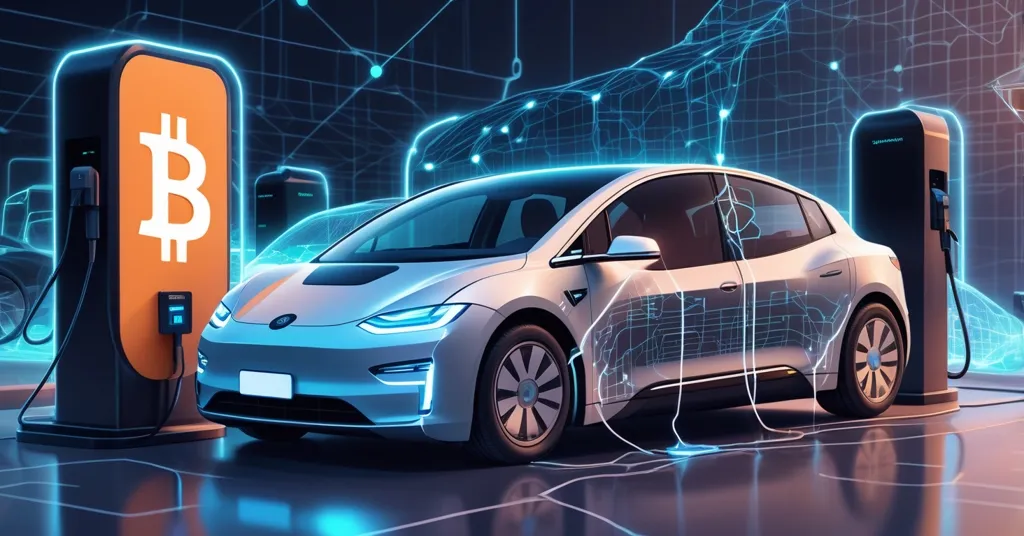Automakers Cut EV Prices After Tax Credit Ends: Blockchain and Bitcoin Solutions?

Automakers Slash EV Prices Post-Tax Credit: A Blockchain and Bitcoin Opportunity?
Major automakers Ford, General Motors (GM), and Hyundai are rolling out significant price cuts on electric vehicles (EVs) following the expiration of the $7,500 federal tax credit on September 30, 2025. While this move aims to keep EV sales afloat amid a strong third quarter, it also opens a door to explore how blockchain and Bitcoin could address pain points in the EV industry, from supply chain opacity to innovative payment systems.
- Tax Credit Expiration: The $7,500 federal EV incentive ended on September 30, 2025, forcing automakers to offset costs with direct discounts.
- Discount Details: Ford and GM offer $7,500 off leased EVs; Hyundai provides rebates on the 2025 Ioniq 5 and cuts up to $9,800 on the 2026 model.
- Market Headwinds: Policy shifts, tariffs, and infrastructure gaps threaten EV adoption, but decentralized tech could offer solutions.
EV Market Under Siege: The End of Federal Incentives
The $7,500 federal tax credit, a cornerstone of the 2022 Inflation Reduction Act—a U.S. policy package designed to boost clean energy adoption—officially expired at the end of September 2025. This credit was a game-changer for many American buyers, softening the blow of EV sticker prices that often dwarf those of traditional gasoline cars. Without it, the upfront cost barrier looms larger than ever, especially when paired with other hurdles like spotty charging networks. For context, EVs can cost anywhere from $40,000 to over $100,000 depending on the model, making every dollar of incentive critical for mainstream adoption.
Ford and GM are stepping in with a direct $7,500 discount on leased EVs already on dealer lots or in transit, a clear bid to clear inventory and keep lease deals attractive through promotions like Ford Credit’s competitive payment plans, which run until December 31, 2025. Hyundai is going a step further, offering $7,500 cash rebates on both purchases and leases of the 2025 Ioniq 5, while slashing prices on the 2026 model by as much as $9,800 depending on the trim level. These are desperate measures to maintain sales momentum, but damn, it’s hard not to see this as a fire sale to keep the electric dream from fizzling out. For more details on these price cuts, check out the report on how Ford, GM, and Hyundai are offsetting the tax credit loss.
Policy Curveballs and Tariff Troubles
Despite these efforts, the EV market faces a brutal road ahead. Ford CEO Jim Farley laid it out plain and simple, forecasting a potential collapse in U.S. EV sales share.
“I wouldn’t be surprised if EV sales in the US go down to 5% from about 10% now. The EV market will be way smaller than we thought,” Farley warned.
Much of this gloom stems from policy shifts under President Donald Trump’s administration, which is doubling down on gasoline and hybrid vehicles over battery-only EVs. On top of that, new tariffs on imported vehicles and parts are set to jack up costs—potentially by $5,500 for imported models and $1,000 for U.S.-built cars with foreign components, according to Cox Automotive research. That’s a gut punch to affordability. EY’s projections rub salt in the wound: U.S. EV market share (the percentage of total new car sales that are electric) is expected to inch up to just 11% by 2029 from 8.1% last year, while Europe and China are on track to surpass 50% by 2032-2033. Why the disparity? High EV prices, unreliable charging infrastructure that’s like dial-up internet in a 5G era, and a policy climate that’s suddenly turned hostile.
Hyundai’s North America Chief Executive Randy Parker, however, sees a light at the end of the tunnel, suggesting a recalibration rather than a collapse.
“Because of the surge we saw in September, there’s going to be a reset in October, maybe November. But the EV market will settle,” Parker said. He added, “There was an EV market before the IRA and there’s gonna be an EV market after the IRA.”
Automakers aren’t just sitting idle. Hyundai is retooling its $5.5 billion Savannah, Georgia plant to produce both hybrid and electric models, hedging against an all-EV gamble. GM Financial pulled a slick move by pre-paying deposits on 30,000 EVs before the October 1 deadline to secure the tax credit for leases, with the IRS reimbursing once deals are finalized. These are chess moves in a game where the board keeps flipping upside down.
Decentralized Solutions: Blockchain and Bitcoin in the EV Space
Now, let’s zoom in on a perspective that hits closer to home for us crypto enthusiasts. The EV industry’s struggles—sky-high costs, policy whiplash, and ethically murky supply chains for battery materials like lithium and cobalt—scream for the kind of disruption decentralized tech can deliver. Blockchain, at its core, is a tamper-proof public ledger that can log every step of a product’s journey, from mining rare earth metals (critical minerals for EV batteries often sourced from geopolitically dicey regions) to final assembly. Imagine a world where you scan a QR code on your EV and see exactly where its battery components came from, verified on a blockchain like Ethereum or a specialized protocol. That’s not just transparency; it’s trust, something automakers desperately need to sell “green” credentials to skeptical buyers.
Projects like IBM’s blockchain initiative for supply chain tracking or BMW’s pilot for cobalt sourcing are already laying groundwork, though they’re early stage and far from mainstream. Bitcoin itself could play a role too. With mining operations increasingly tapping renewable energy—over 50% of BTC mining used renewables as of 2023 per the Cambridge Bitcoin Electricity Consumption Index—there’s potential for miners to offset EV production’s carbon footprint through energy partnerships. Hell, why not push the envelope further? Picture buying your next EV directly with BTC, cutting out bloated banking fees, or earning tokenized incentives (digital certificates of value on a blockchain) for choosing sustainable models. It’s the kind of middleman-slaying innovation we live for.
But let’s not get too starry-eyed. Face it, the energy demands of both EV production and crypto mining raise red flags, especially on coal-heavy grids. Blockchain adoption in high-volume industries like automotive faces scalability hiccups—transaction costs and speed on networks like Ethereum can’t yet handle the data deluge of global supply chains. And tokenized EV incentives or Bitcoin payments? They’re a regulatory minefield in the U.S., where crypto is still the Wild West, and consumer hesitance to use volatile assets for big-ticket purchases is real. Tariffs tightening automaker budgets might also mean less R&D cash for fancy tech like blockchain integration. It’s a long shot, no sugarcoating it, but the potential to outlast centralized policy flops keeps us intrigued.
Broader Implications: Centralized Failures, Decentralized Futures?
Stepping back, the EV market’s turbulence is a glaring expose of centralized systems’ fragility. Tax credits vanish, tariffs spike, and political whims flip entire industries on their heads—sound familiar? It’s the same top-down nonsense Bitcoin was born to disrupt in finance. If automakers are scrambling to offset a $7,500 gap, imagine how a decentralized payment rail like BTC could bypass those markups entirely, or how blockchain could track charger buildouts transparently to fix infrastructure woes. Sure, altcoins like Ethereum have their place with smart contracts for tokenization, but Bitcoin’s security and global reach make it the ultimate contender for a borderless EV economy. That said, we’re not blind to the hurdles—regulation, adoption, and grid strain aren’t going away overnight.
Historically, tech disruptions like PayPal in early online payments faced similar growing pains, taking years to gain traction. Blockchain’s role in EVs might be a decade-long play, but if centralized policies keep stumbling, decentralized solutions could steal the show. For now, automakers are in survival mode, and we’re watching hawk-eyed for the first mover to bet big on crypto tech. Will it stick, or flop like a bad altcoin? Only time will tell.
Key Takeaways and Questions on EVs, Blockchain, and Bitcoin
- What led to the expiration of the $7,500 EV tax credit in 2025?
This federal incentive, part of the 2022 Inflation Reduction Act to drive clean energy adoption, ended on September 30, 2025, as per its legislative timeline, hitting EV affordability hard. - How are Ford, GM, and Hyundai tackling the tax credit loss?
Ford and GM are cutting $7,500 off leased EV prices, while Hyundai matches with rebates on the 2025 Ioniq 5 and slashes up to $9,800 on 2026 models to sustain buyer interest. - How might Trump’s policies and tariffs impact EV and crypto adoption?
Prioritizing gasoline and hybrids, plus tariffs adding up to $5,500 to EV costs, could shrink market share and slow blockchain or Bitcoin integration due to tightened budgets. - Why does the U.S. lag behind Europe and China in EV growth?
High costs, shaky charging networks, and policy gaps project U.S. EV sales at 11% by 2029, while Europe and China race toward over 50% by the early 2030s. - How can blockchain reshape the EV industry’s supply chain?
It enables transparent tracking of battery materials like lithium, ensuring ethical sourcing and building trust, though scalability and regulatory barriers loom large. - Is there a future for Bitcoin and crypto payments in EV purchases?
Bitcoin could enable low-fee, global transactions for EVs, and tokenized incentives on platforms like Ethereum might reward buyers, but volatility and legal roadblocks pose challenges.



